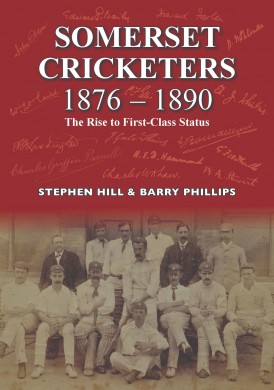Somerset Cricketers 1876-1890: The Rise to First Class Status
Martin Chandler |Published: 2021
Pages: 296
Author: Hill, Stephen and Phillips, Barry
Publisher: Private
Rating: 4 stars

Between 2016 and 2019 Stephen Hill and Barry Phillips produced an excellent series of books which, together, completed the task of telling the stories of each and every man who has appeared in First Class cricket for Somerset between the county making its bow in 1882, and 2000. The first covered 1882-1914, the second 1919-1939, the third 1946-1970 and, finally and without Phillips involvement this time, 1971-2000.
I recall Stephen Hill telling me at the time the fourth book was published he had no plans to attempt to continue the series into the 21st century, so was surprised to learn a few months ago that a fifth book was in the course of preparation. It turned out however that the new addition was to be a prequel rather than a sequel, and was a similar book covering the years from the first appearance of a Somerset club to their acquisition of First Class status. The inconsistency in the dates is explained by a hiatus between 1886 and 1890 when the First Class status first awarded in 1882 was taken away.
The first four books were published by Halsgrove who, apparently, felt this one a bit too niche for them. They are, I suppose, probably right, so although this prequel is in the style of its predecessors, and benefits from the same high quality production standards, it has been privately published in a limited edition of one hundred and ten individually signed and numbered copies. A modest price tag of £25 including UK postage means that by the time this review appears there may well be very few copies left in the UK, although I believe a few are currently en route to the Roger Page emporium in Melbourne.
Those expecting more of the same from Phillips and Hill are not going to be disappointed. The format of the book is very similar to its predecessors although, unsurprisingly, it has not proved possible to find a photograph of all of the 84 men featured, nor to produce a facsimile of all their signatures. The only significant departure, understandable and helpful in view of the county’s status over the period, are brief details of the matches played, the opponents being a mix of the First Class counties, Minor Counties and club sides.
So who are the characters this time round? None are well known cricketers but, as this series has consistently demonstrated, an interesting life story does not require its subject to have excelled at the game. In his introduction Phillips singles out three individuals, and he has probably selected the three most interesting. There is Arthur Treadgold, who made a fortune in the Klondike gold fields, and lost it again. The other two are Fred Cole, a serial fantasist who told many tall stories about himself, and Arthur Dickens, a man from a good family who turned out to most definitely be a ‘wrong ‘un’. None have distinguished playing records.
The book has its fair share of sadness as well, something that in many ways stalked the era. Dickens eventually took his own life, and rather more tragic was the case of Charles Law who, as Second Lieutenant Law, was killed in the Sudan in 1885, a mere quarter of an hour after seeing action for the first time.
There are family connections too. One of the giants of Somerset cricket is Sammy Woods. I never realised that Woods had a brother, but now know that his younger brother, Harris, also played for Somerset. In two matches Woods Jnr’s contributions were modest in the extreme but he seems, like his famous sibling, to have been a fine all-round sportsman and the reader is left wondering whether his name, had he chosen to stay in Somerset like Sam rather than return to Australia, might still resonate today.
Another interesting character is William Evans, another story that contains much sadness. Evans was the older brother of Harry Evans, a man who features in the first book in the series and who founded Douglas Jardine’s alma mater, Horris Hill preparatory school near Newbury. William’s family lost his wife, himself and two sons in tragic circumstances. It is perhaps as well that Harry’s son, the once (against Gregory and McDonald in 1921) capped John Evans threw in his lot with Hampshire and Kent rather than Somerset, as were Phillips and Hill dealing with his remarkable life then given the depth of research they habitually put in they would probably have needed a sixth volume.
It is not difficult to understand why Halsgrove decided that Somerset Cricketers 1876-1890 was not for them, but that does not mean that the book loses anything in comparison with its bulkier brethren. It is nonetheless for hardened tragics only, but for that hardy band it is highly recommended.






Leave a comment